6.4 Exercise Problems
Q1. Draw illustrations to bring out the anatomical differences between
(a) Monocot root and Dicot root
(b) Monocot stem and Dicot stem
Answer: (a) Monocot root and dicot root
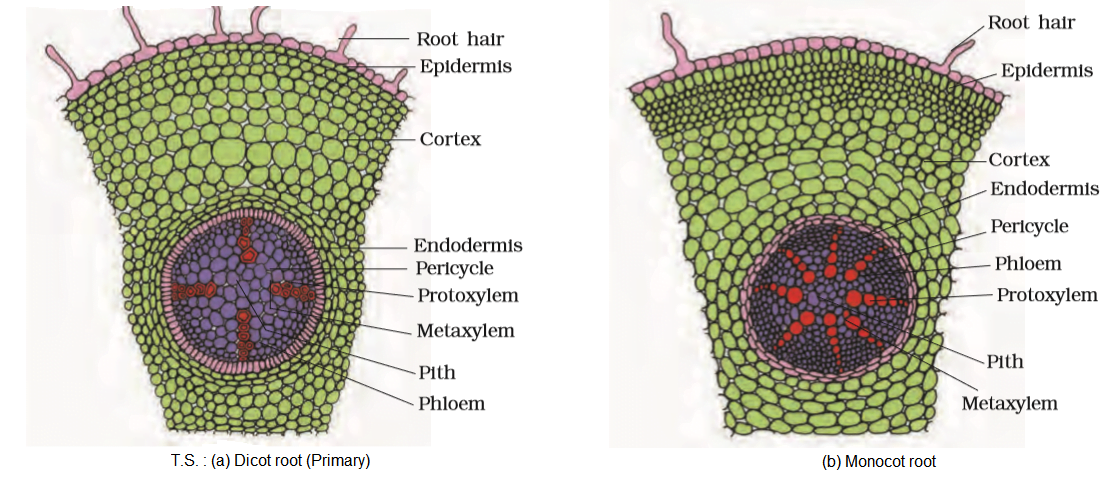
(b) Monocot stem and dicot stem
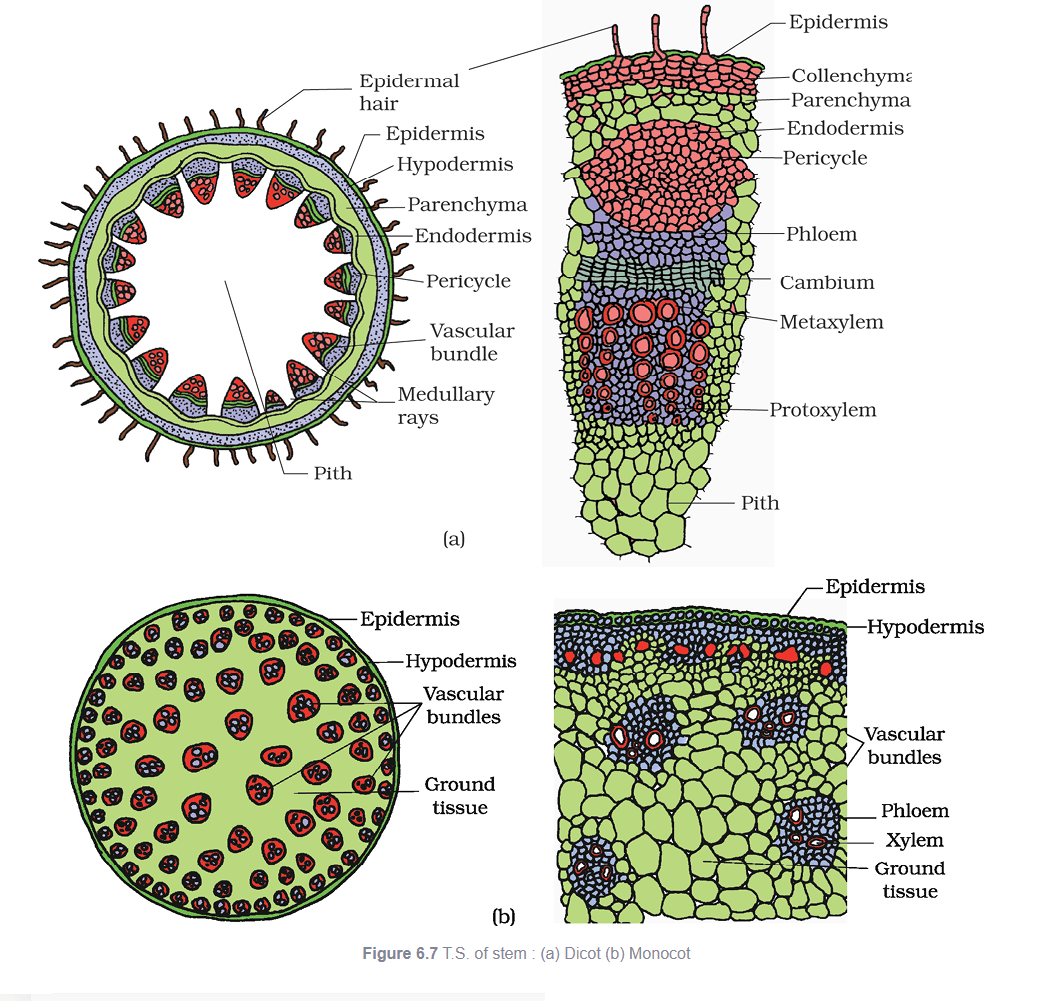
Q2. Cut a transverse section of the young stem of a plant from your school garden and observe it under the microscope. How would you ascertain whether it is a monocot stem or a dicot stem? Give reasons.
Answer: The dicot stem is characterised by the presence of conjoint, collateral, and open vascular bundles, with a strip of cambium between the xylem and phloem. The vascular bundles are arranged in the form of a ring, around the centrally-located pith. The ground tissue is differentiated into the collenchyma, parenchyma, endodermis, pericycle, and pith. Medullary rays are present between the vascular bundles.
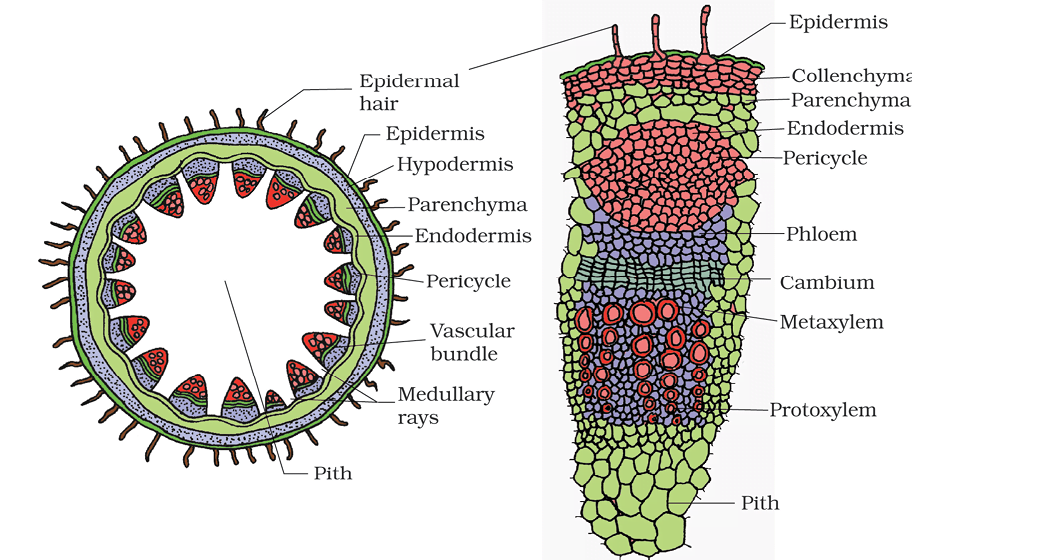
The monocot stem is characterised by conjoint, collateral, and closed vascular bundles, scattered in the ground tissue containing the parenchyma. Each vascular bundle is surrounded by sclerenchymatous bundle-sheath cells. Phloem parenchyma is absent and water-containing cavities are present.
Q3. The transverse section of a plant material shows the following anatomical features – (a) the vascular bundles are conjoint, scattered and surrounded by a sclerenchymatous bundle sheaths. (b) phloem parenchyma is absent. What will you identify it as?
Answer: The monocot stem is characterised by conjoint, collateral, and closed vascular bundles, scattered in the ground tissue containing the parenchyma. Each vascular bundle is surrounded by sclerenchymatous bundle-sheath cells. Phloem parenchyma and medullary rays are absent in monocot stems.
Q4. What is stomatal apparatus? Explain the structure of stomata with a labelled diagram.
Answer: Stomata are small pores present in the epidermis of leaves. They regulate the process of transpiration and gaseous exchange. The stomatal pore is enclosed between two bean-shaped guard cells. The inner walls of guard cells are thick, while the outer walls are thin. The guard cells are surrounded by subsidiary cells. These are the specialized epidermal cells present around the guard cells. The pores, the guard cells, and the subsidiary cells together constitute the stomatal apparatus.

Q5. Name the three basic tissue systems in the flowering plants. Give the tissue names under each system.
Answer:
\(\begin{array}{lll}
\text { No. } & {\text { Tissue system }} & {\text { Tissues present }} \\
\mathbf{1} & \text { Epidermal tissue system } & \text { Epidermis,trichomes,hairs,stomata } \\
\mathbf{2} & \text { Ground tissue system } & \text { Parenchyma,collenchyma,sclerenchyma,mesophyll } \\
\mathbf{3} & \text { Vascular tissue system } & \text { Xylem,pholem,cambium } \\
\end{array}
\)
Q6. How is the study of plant anatomy useful to us?
Answer: The study of plant anatomy helps us to understand the structural adaptations of plants with respect to diverse environmental conditions. It also helps us to distinguish between monocots, dicots, and gymnosperms. Such a study is linked to plant physiology. Hence, it helps in the improvement of food crops. The study of plant structure allows us to predict the strength of wood. This is useful in utilising it to its potential. The study of various plant fibres such as jute, flax, etc., helps in their commercial exploitation.
Q7. Describe the internal structure of a dorsiventral leaf with the help of labelled diagrams.
Answer: Dorsiventral leaves are found in dicots. The vertical section of a dorsiventral leaf contains three distinct parts.
[1] Epidermis:
The epidermis is present on both the upper surface (adaxial epidermis) and the lower surface (abaxial epidermis). The epidermis on the outside is covered with a thick cuticle. The abaxial epidermis bears more stomata than the adaxial epidermis.
[2] Mesophyll:
Mesophyll is a tissue of the leaf present between the adaxial and abaxial epidermises. It is differentiated into the palisade parenchyma (composed of tall, compactly-placed cells) and the spongy parenchyma (comprising oval or round, loosely-arranged cells with inter-cellular spaces). Mesophyll contains the chloroplasts which perform the function of photosynthesis.
[3] Vascular system:
The vascular bundles present in leaves are conjoint and closed. They are surrounded by thick layers of bundle-sheath cells.
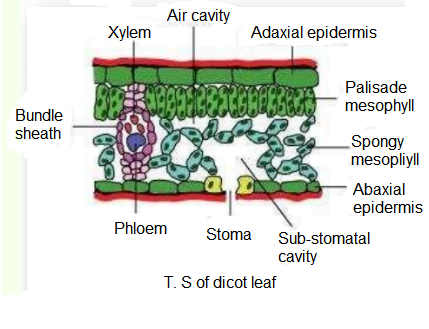
Exemplar Section
VERY SHORT ANSWER TYPE QUESTIONS
Q1. Product of photosynthesis is transported from the leaves to various parts of the plants and stored in some cell before being utilised. What are the cells/ tissues that store them?
Answer: The food gets stored in specialised parenchymatous cells present either in roots and stems or in their modifications in the form of a polysaccharide called starch.
Q2. Protoxylem is the first formed xylem. If the protoxylem lies next to phloem what kind of arrangement of xylem would you call it?
Answer: If phloem lies next to protoxylem, this kind of arrangement of xylem is called exarch.
Q3. What is the function of phloem parenchyma?
Answer: The phloem parenchyma stores food material and other substances like resins, latex and mucilage.
Q4. What is present on the surface of the leaves which helps the plant prevent loss of water but is absent in roots?
Answer: Cuticle is present on the surface of the leaves which helps the plant prevent loss of water but is absent in roots.
Q5. What is the epidermal cell modification in plants which prevents water loss?
Answer: In grasses, certain adaxial epidermal cells along the veins modify themselves into large, empty, colourless cells. These are called bulliform cells or motor cells. Bulliform cells help in folding and unfolding of grass leaves.
When the bulliform cells in the leaves have absorbed water and are turgid, the leaf surface is exposed. When they are flaccid due to water stress, they make the leaves curl inwards (inrolling) to minimise water loss (transpiration).
Q6. What part of the plant would show the following:
a. Radial vascular bundle
b. Polyarch xylem
c. Well developed pith
Answer: a. Radial vascular bundle: Root
b. Polyarch xylem: Monocot root
c. Well developed pith: Dicot stem and monocot root
Q7. What are the cells that make the leaves curl in plants during water stress?
Answer: Bulliform/motor cells
Q8. What constitutes the cambial ring?
Answer: Interfascicular cambium + intrafascicular cambium.
Q9. The cross-section of a plant material showed the following features when viewed under the microscope.
a. The vascular bundles were radially arranged.
b. Four xylem strands with exarch condition of protoxylem.
To which organ should it be assigned?
Answer: Dicot root
Q10. What do hard wood and soft wood stand for?
Answer: Gymnosperm wood is called softwood due to absence of vessels (therefore it is called non-porous wood). Dicot angiospermic wood is called hardwood because it possess abundant vessels.
SHORT ANSWER TYPE QUESTIONS
Q1. While eating peach or pear it is usually seen that some stone like structures get entangled in the teeth, what are these stone like structures called?
Answer: The structures that get entangled in the teeth while eating fruits like peach and pear are actually the stone cells or brachysclereids which are unbranched, short and isodiametric type of sclereids. These stone cells usually occur in groups and provide grit or stone like hardness that get entangled in the spaces between teeth.
Q2. Below is a list of plant fibres. From which part of the plant these are
obtained
a. Coir
b. Hemp
c. Cotton
d. Jute
Answer: a. Coir—Mesocarp of coconut fruit (drupe)
b. Hemp—Phloem or bast fibre
c. Cotton—Epidermal hair of seed
d. Jute—Phloem or bast fibre
Q3. What are the characteristic differences found in the vascular tissue of gymnosperms and angiosperms?
Answer:
- Xylem functions as a conducting tissue for water and minerals from roots to the stem and leaves. It also provides mechanical strength to the plant parts. It is composed of four different kinds of elements, namely, tracheids, vessels, xylem fibres and xylem parenchyma. Gymnosperms lack vessels in their xylem.
- Phloem transports food materials, usually from leaves to other parts of the plant. Phloem in angiosperms is composed of sieve tube elements, companion cells, phloem parenchyma and phloem fibres. Gymnosperms have albuminous cells and sieve cells. They lack sieve tubes and companion cells.
Q4. Epidermal cells are often modified to perform specialized functions in plants. Name some of them and the function they perform.
Answer:
- Root hairs: The root hairs are unicellular elongations of the epidermal cells and help absorb water and minerals from the soil.
- Stem hairs or trichomes: On the stem the epidermal hairs are called trichomes. The trichomes in the shoot system are usually multicellular. They may be branched or unbranched and soft or stiff. They may even be secretory. The trichomes help in preventing water loss due to transpiration.
- Bulliform cells: In grasses, certain adaxial epidermal cells along the veins modify themselves into large, empty, colourless cells. These are called bulliform cells. When the bulliform cells in the leaves have absorbed water and are turgid, the leaf surface is exposed. When they are flaccid due to water stress, they make the leaves curl inwards to minimise water loss.
Q5. The lawn grass (Cynodon dactylon) needs to be mowed frequently to prevent its overgrowth. Which tissue is responsible for its rapid growth?
Answer: Intercalary meristem: The meristem which occurs between mature tissues is known as intercalary meristem. They occur in grasses and regenerate parts removed by the grazing herbivores.
Q6. Plants require water for their survival. But when watered excessively, plants die. Discuss.
Answer: Irrigation without proper drainage of water leads to waterlogging in the soil. Besides affecting the crops, waterlogging draws salt to the surface of the soil. The salt then is deposited as a thin crust on the land surface or starts collecting at the roots of the plants. This increased salt content is inimical to the growth of crops and is extremely damaging to agriculture and plants may die.
Q7. A transverse section of the trunk of a tree shows concentric rings which are known as growth rings. How are these rings formed? What is the significance of these rings?
Answer: The activity of cambium is under the control of many physiological and environmental factors. In temperate regions, the climatic conditions are not uniform through the year. In the spring season, cambium is very active and produces a large number of xylary elements having vessels with wider cavities. The wood formed during this season is called spring wood or early wood. In winter, the cambium is less active and forms fewer xylary elements that have narrow vessels, and this wood is called autumn wood or late wood.
The spring wood is lighter in colour and has a lower density whereas the autumn wood is darker and has a higher density. The two kinds of woods that appear as alternate concentric rings, constitute an annual ring. Annual rings seen in a cut stem give an estimate of the age of the tree.
Q8. Trunks of some of the aged tree species appear to be composed of several fused trunks. Is it a physiological or anatomical abnormality? Explain in detail.
Answer: Trunks of some of the aged tree species appear to be composed of several fused trunks. It is an anatomical abnormality. It is due to the abnormal secondary growth.
Q9. What is the difference between lenticels and stomata?
Answer: At certain regions, the phellogen cuts off closely arranged parenchymatous cells on the outer side instead of cork cells. These parenchymatous cells soon rupture the epidermis, forming a lens-shaped openings called lenticels.
- Lenticels permit the exchange of gases between the outer atmosphere and the internal tissue of the stem. These occur in most woody trees. Lenticels remains open permanently.
- Stomata are structures present in the epidermis of leaves. Stomata regulate the process of transpiration and gaseous exchange. Each stoma is composed of two beanshaped cells known as guard cells which enclose stomatal pore. In grasses, the guard cells are dumb-bell shaped. The outer walls of guard cells (away from the stomatal pore) are thin and the inner walls (towards the stomatal pore) are highly thickened. The guard cells possess chloroplasts and regulate the opening and closing of stomata.
Q10. Write the function of
a. Sieve tube
b. Interfasicular cambium
c. Collenchyma
d. Aerenchyma
Answer: a. Sieve tube—Conduction of food
b. Interfasicular cambium—Formation of vascular cambium
c. Collenchyma—Mechanical support
d. Aerenchyma—Provides buoyancy
Q11. The stomatal pore is guarded by two kidney shaped guard cells. Name the epidermal cells surrounding the guard cells. How does a guard cell differ from an epidermal cell? Use a diagram to illustrate your answer.
Answer: Stomata are structures present in the epidermis of leaves. Stomata regulate the process of transpiration and gaseous exchange. Each stoma is composed of two beanshaped cells known as guard cells which enclose stomatal pore. The guard cells possess chloroplasts which are absent in other epidermal cells. Sometimes, a few epidermal cells, in the vicinity of the guard cells become specialised in their shape and size and are known as subsidiary ceils.
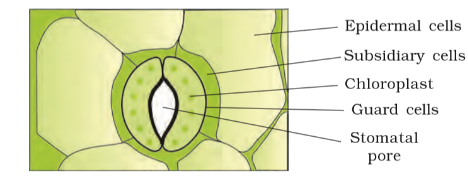
Q12. Point out the differences in the anatomy of, leaf of peepal (Ficus religiosa) and maize (Zea mays). Draw the diagrams and label the differences.
Answer:
\(
\begin{array}{|l|l|}
\hline \text { Dicot leaves } & \text { Monocot leaves } \\
\hline \text { 1. Dorsiventral } & \text { 1. Isobilateral } \\
\hline \begin{array}{l}
\text { 2. Stomata are usually present on the lower } \\
\text { surfaces. }
\end{array} & \text { 2. Surface equally present on both surfaces. } \\
\hline \text { 3. Stomata have bean-shaped guard cells. } & \begin{array}{l}
\text { 3. Stomata have dumbbell-shaped guard } \\
\text { cells. }
\end{array} \\
\hline \begin{array}{l}
\text { 4. Mesophyll is differentiated in palisade and } \\
\text { spongy parenchyma. }
\end{array} & \text { 4. Mesophyll is undifferentiated. } \\
\hline \text { 5. Bulliform cells are absent. } & \text { 5. Bulliform cells are present. } \\
\hline
\end{array}
\)
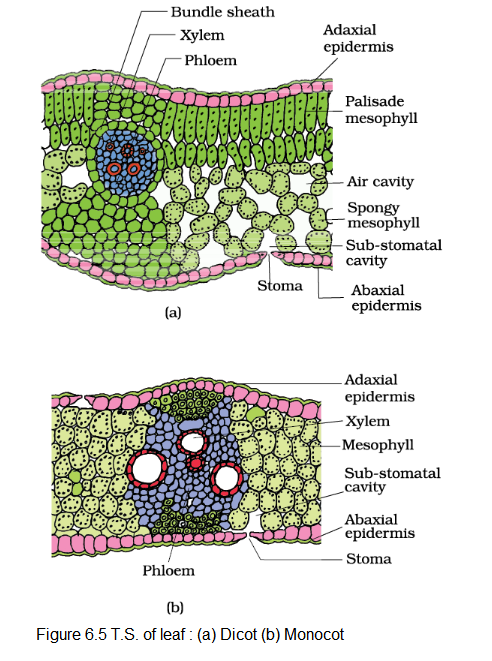
Q13. Palm is a monocotyledonous plant, yet it increases in girth. Why and how?
Answer: A palm tree is a monocotyledonous plant and like all other monocots the stems do not have primary cambium in the vascular bundles. However, with age, the tree grows in diameter, though slowly, as a result of the growth of the ground tissue. A secondary cambium may be formed in the hypodermal region of the stem. The later forms the conjunctive tissue and patches of meristematic cell. The activity of the meristematic cells result in the formation of secondary vascular bundles.
LONG ANSWER TYPE QUESTIONS
Q1. The arrangement of ovules within the ovary is known as placentation. What does the term placenta refer to? Draw various types of placentations in the flower as seen in T.S. and V.S.
Answer: Placentation: The arrangement of ovules within the ovary is known as placentation. The placentation are of different types namely, marginal, axile, parietal, basal, central and free central. In marginal placentation, the placenta forms a ridge along the ventral suture of the ovary and the ovules are borne on this ridge forming two rows, as in pea. When the placenta is axial and the ovules are attached to it in a multilocular ovary, the placentation is said to be axile, as in china rose, tomato and lemon. In parietal placentation, the ovules develop on the inner wall of the ovary or on peripheral part. Ovary is onechambered but it becomes two-chambered due to the formation of the false septum, e.g., mustard and Argemone. When the ovules are borne on central axis and septa are absent, as in Dianthus and Primrose the placentation is called free central. In basal placentation, the placenta develops at the base of ovary and a single ovule is attached to it, as in sunflower, marigold.
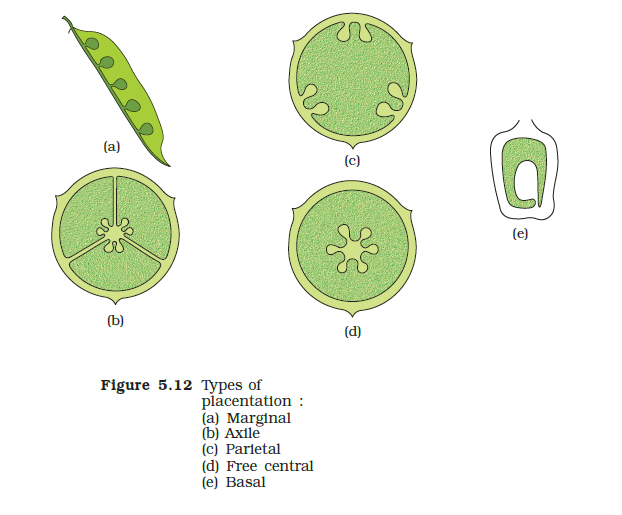
Q2. Is Pinus an evergreen tree? Comment
Answer: Yes, Pinus trees are evergreen, coniferous resinous trees. The leaves in gymnosperms are well-adapted to withstand extremes of temperature, humidity and wind. In conifers, the needle-like leaves reduce the surface area. Their thick cuticle and sunken stomata also help to reduce water loss. Unlike deciduous plants, Pinus do not shed their leaves so it is an evergreen tree.
Q3. Assume that a pencil box held in your hand, represents a plant cell. In how many possible planes can it be cut? Indicate these cuts with the help of line drawings.
Answer: When any plane passing through the central axis of the plant cell divides the cell into two identical halves, it is called radial symmetry. If the plant cell
can be divided into identical left and right halves in only one vertical plane, exhibit bilateral symmetry.
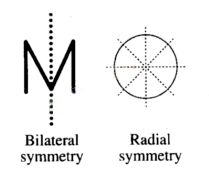
Q4. Each of the following terms has some anatomical significance. What do
these terms mean? Explain with the help of line diagrams.
a. Plasmodesmata
b. Middle lamella
c. Secondary wall
Answer: a. Plasmodesmata are the protoplasmic strands between adjacent plant cells. Plasmodesmata connections help in movement of substances between cells.
b. The middle lamella is a layer mainly of calcium pectate which holds or glues the different neighbouring cells together. Middle lamella is made up of calcium pectate (mainly) and magnesium pectate. During ripening a fruit becomes soft and pulpy due to dissolution of middle lamella.
c. The cell wall of a young plant cell, the primary wall is capable of growth, which gradually diminishes as the cell matures and the secondary wall is formed on the inner (towards membrane) side of the cell. Secondary wall may have the deposition of lignin. Secondary wall help in the differentiation of the cell.
Q5. Distinguish between the following:
a. Exarch and endarch
b. Stele and vascular bundle
c. Protoxylem and metaxylem
d. Interfasicular cambium and intrafasicular cambium
e. Open and closed vascular bundles
f. Stem hair and root hair
Answer: (a) Exarch and endarch condition of protoxylem: In stems, the protoxylem lies towards the centre (pith) and the metaxylem lies towards the periphery of the organ. This type of primary xylem is called endarch. In roots, the protoxylem lies towards periphery and metaxylem lies towards the centre. Such arrangement of primary xylem is called exarch.
(b) Stele and vascular bundle: All tissues on the innerside of the endodermis such as pericycle, vascular bundles and pith constitute the stele. The vascular system consists of complex tissues, the phloem and the xylem. The xylem and phloem together constitute vascular bundles.
(c) Protoxylem and metaxylem: Primary xylem is of two types – protoxylem and metaxylem. The first formed primary xylem elements are called protoxylem and the later formed primary xylem is called metaxylem.
(d) Interfasicular cambium and intrafasicular cambium: In dicot stems, the cells of cambium present between primary xylem and primary phloem is the intrafascicular cambium. The cells of medullary rays, adjoining these intrafascicular cambium become meristematic and form the interfascicular cambium.
(e) Open and closed vascular bundles: In dicotyledonous stems, cambium is present between phloem and xylem. Such vascular bundles because of the presence of cambium possess the ability to form secondary xylem and phloem tissues, and hence are called open vascular bundles. In the monocotyledons, the vascular bundles have no cambium present in them. Hence, since they do not form secondary tissues they are referred to as closed.
(f) Stem hair and root hair: The root hairs are unicellular elongations of the epidermal cells and help absorb water and minerals from the soil. On the stem the epidermal hairs are called trichomes or stem hairs. The trichomes in the shoot system are usually multicellular. They may be branched or unbranched and soft or stiff. They may even be secretory. The trichomes help in preventing water loss due to transpiration.